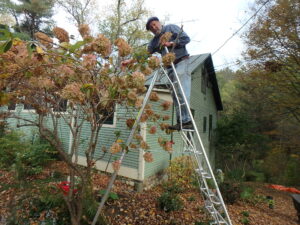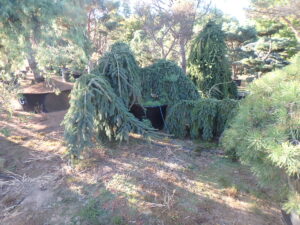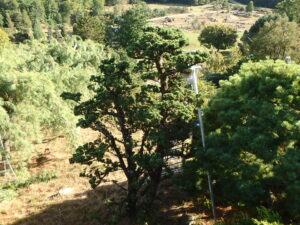The Art of Japanese Pruning
Posted on Tuesday, October 6, 2020 · Leave a Comment
A few weeks ago I traveled to Shin Boku Nursery in Wentworth, NH to attend an all-day workshop on Japanese pruning techniques. Many of the techniques are useful to any gardener.
The workshop was organized and taught by Doug Roth, the publisher of Sukiya Living magazine (
www.rothteien.com), a journal about Japanese gardening that my wife and I subscribe to. It provides practical and aesthetic advice that I find useful anywhere. Mr. Roth lived for years in Japan, and apprenticed under a Japanese master, ultimately receiving accreditation as a journeyman gardener.
Shin Boku (
www.shin-bokunursery.com/) is a specialty nursery that offers trees and shrubs trained for use in Japanese-inspired gardens. The owner, Palmer Koelb, has been growing specialty trees pruned in the Japanese style there since 1986, and some of the larger trees (in 5-foot diameter pots) he has been training for even longer. There is a lovely Japanese garden there as well as specimen trees for sale.

Henry on Japanese pruning ladder
The workshop began with a lesson on ladder safety. Japanese pruning ladders made by Hasegawa were present for us to see and use. These ladders are tripod ladders made especially for pruning. They are made of welded aluminum, and are very light.
Their 2 front legs flare, shaped much like a side of the Eiffel Tower, and a third leg is hinged so that it can be swung out and placed inside or behind a hedge or tree. Not only that, the third leg can be extended or shortened to work on hillsides. The feet are clawed, so they dig into the soil, but they come with rubber “sneakers” to use on pavement or stone. The steps are wide and comfortable on the feet, and some have an upper platform for working.
After a day of using the Hasegawa ladders, I was convinced that they offer safety and convenience way beyond what my old-fashioned step ladders and extension ladders offer, particularly on rough terrain and hillsides. When I got home I made arrangements to buy my own from Alan Bissonnette in Chichester, New Hampshire. He represents New England Ladders (
www.neladders.com), which has representatives and warehouses around the country. Visit
www.neladders.com/dealer-locator/ to find a dealer near you.
The ladder I selected is a 10-footer, one with a platform at the 8-foot level, and a grab bar on the top. I have been using it on hilly terrain, and love that not only can I adjust the length of the third (back) leg, it has a chain connecting the front legs and the back legs to assure that the ladder cannot splay more than recommended. I was tempted to get an 8-foot ladder, but have been pleased with the extra height. I like being able to look down on the top of a medium-size crab apple tree to see what needs to be removed. My new ladder weighs just 30 pounds.

Large trees pruned in the Japanese tradition are available at Shin-Boku nursery
In Japanese gardens the trees are often trained to irregular shapes. That can be accomplished by regular pruning and understanding how to direct growth. The tip of a branch produces auxins, or plant hormones that control growth and fruiting. By cutting back a branch to a junction of branches, one can direct growth. Cut off the tip and one of a pair of side branches, and the growth will essentially follow the direction of the remaining branch. In this way, a tree can be made to twist and turn over time.
Some evergreens produce so many branches and leaves that the interior of the shrub or tree gets little or no light. The interior of those specimens can then lose their leaves (commonly called needles), leaving a dark interior that is unattractive if an outer branch is damaged or removed. You can prevent that with judicious pruning.
I recently worked on a “Bird’s Nest’ spruce. It was a large shrub that was getting too tall and wide, and the homeowner wanted it made smaller. This, I explained, is a multi-year project: if I just cut off the top branches, the brown interior would be exposed and unsightly.
Here’s what I did: First, I cut back this year’s growth to stop the shrub from getting bigger. Then I removed some small branches to allow punches of light to get inside the tree. That will stimulate dormant buds to grow new leaves. I did this primarily where two branches were growing parallel – I removed one, left the other. I did this not only on the top of the shrub, but on the sides as well.
In the workshop each of us received a copy of “Sukiya Living Textbook: Advanced Tree Pruning”. It is nicely illustrated with photographs showing several different styles of pruning techniques, mainly for evergreen shrubs and small trees.

Pine shaped in the Japanese tradition at Shin-Boku Nursery
If you are interested in creating a tranquil corner of your property into a small Japanese garden, I suggest you subscribe to Sukiya Living magazine. It comes out bi-monthly and, according to their website, covers “various aspects of Japanese architecture, horticulture, art, and philosophy. Topics range from centuries-old design principles to modern, how-to construction and maintenance techniques.”
I hope one day to travel with Doug Roth on one of his tours of gardens in Kyoto, Japan. I just will have to wait until Covid 19 has been controlled and a vaccine is available. Meanwhile, I can dream.
You may reach Henry at
henry.homeyer@comcast.net or PO Box 364, Cornish flat, NH 03746. He is the author of 4 gardening books.





